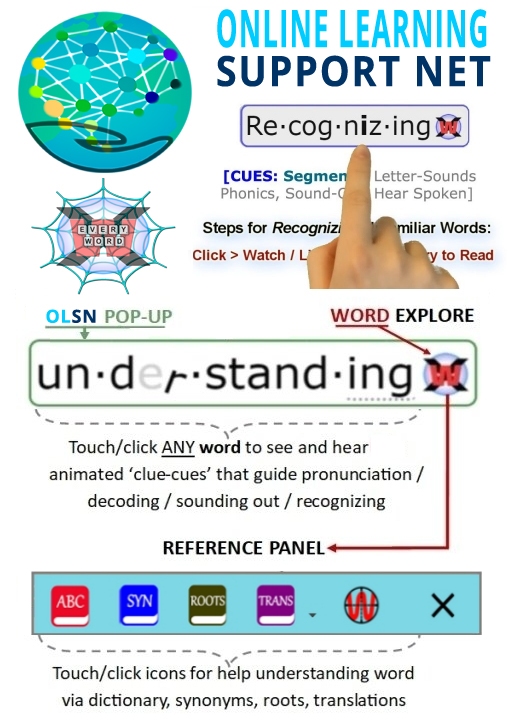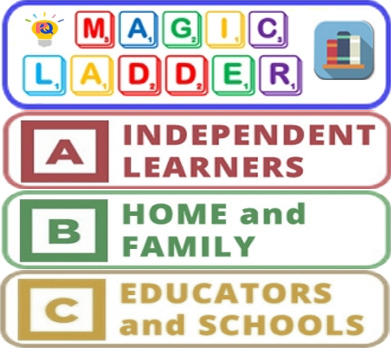Eye Movements
Note: Remember to click on any word on this page to experience the next evolutionary step in technology supported reading.
The Processes of Skilled Reading
I largely approach it by recording their eye movements while they read, and then try to infer what the mental processes are. We also do things where we make changes in the text, contingent on the eye movements. So, the classic experiment is one where we control how much you can see on each eye fixation via what’s called the “moving window technique.” Or we have also used another technique called the “boundary technique,” where you’re reading along, and there’s a word off to the right of where your eye is, but then when your eye goes into motion that word changes to another word.
What we do is vary the relationship between the first word and the second word, so they can be semantically, phonologically or orthographically related. Then we try to infer what kind of information you would be getting from that word before you got to it, as a function of the relationship between the first and second word, and how long you then look at the word that’s there when your eyes get there.
Then the other thing I do a lot of is have people read sentences or text that do indeed have ambiguities in them, so there would be phonological ambiguity or lexical ambiguities or syntactic ambiguities. So they might read a sentence like, “While Mary was mending, the socks fell off her lap.” And there may or may not be a comma after mending, but if there’s not a comma after was mending, then usually people misplace the sentence because they take the sock to be the object that the verb was mending, and then they’re all messed up. So we try and infer what kind of structures are they building as they read to help them parse the sentence.
Keith Rayner, Distinguished Professor, Psychology Department, University of Massachusetts; Director of the University’s Eyetracking Laboratory. Source: COTC Interview – http://www.childrenofthecode.org/interviews/rayner.htm#SkilledReading
Ambiguity Processing Takes Time
Dr. Keith Rayner: So that, indeed, when people read a word that’s irregular — do you know what I mean by irregular, like pint? All the other words that end in I-N-T are like hint and things like that. But then pinthas a different — they might think it’s going to be pint with a short i sound by virtue of all the other things. When you encounter those kind of words as you read, and look at them, your eyes pause longer on them.
David Boulton: Right. So there is a correspondence between processing time and ambiguity. We could say that it’s possible, though we may not have done it yet, to lay out a map of these nested levels of ambiguity that are involved in the challenge.
Dr. Keith Rayner: Right.
Keith Rayner, Distinguished Professor, Psychology Department, University of Massachusetts; Director of the University’s Eyetracking Laboratory. Source: COTC Interview – http://www.childrenofthecode.org/interviews/rayner.htm#AmbiguityProcessingTakesTime
The Time it Takes to Make Meanings
The time estimates that we’ve tried to map out are: How long does it take to go from the printed representation to the sort of lexical access to understand the meaning. That’s where a lot of our focus has been. So, we’ve built a model of the reading process. Basically, it’s a simulation, where we predict where people will look, how long they’ll look at a word, which words they’ll skip, and things like that. The model does a pretty good job of doing that. Implicit in the model is the assumption that lexical access is taking place in around somewhere — you know, about 150 milliseconds or so, or less.
But in terms of how long does it take to map the graphemic features onto the phonological features, I don’t know that I’d have a good time frame there. We have done experiments where we try and map out how quickly the different types of information are getting into the system. There it looks like orthography obviously comes first, and phonology comes in pretty quickly.
Keith Rayner, Distinguished Professor, Psychology Department, University of Massachusetts; Director of the University’s Eyetracking Laboratory. Source: COTC Interview – http://www.childrenofthecode.org/interviews/rayner.htm#TheTimeItTakestoMakeMeanings
Word Recognition Timing Thresholds in Skilled Readers
Dr. Keith Rayner: What I know for adults, which is where all of our work is done, is that it takes about fifty milliseconds to get the information into the system. We’ve done experiments where people are reading, and if we mask the text or we take it away, but they get to see it for fifty milliseconds, that’s enough time.
David Boulton: So, by controlling how long something appears, you can find out what the recognition threshold is?
Dr. Keith Rayner: We can get the threshold for: How long does this stuff have to be there to get it into the system? If we leave it up for less than fifty milliseconds then reading falls apart; it’s really disrupted. But if we give them fifty or sixty milliseconds to see the text, then the orthographic information that’s there in front of their eyes gets into the system. It doesn’t matter if the text goes away after that. In fact, there are interesting things like if they’re looking at a low frequency word — so when you read normally, right, and we record your eye movements, you’ll always look longer at a low frequency word than a high frequency word. Even when we take the text away or mask it so it’s not there anymore, the eyes will stay in place longer for the low frequency word than the high frequency word, which is pretty interesting. So, that’s basically saying the mental operations that are involved in figuring out what that word is are driving the eye movements through the text.
Keith Rayner, Distinguished Professor, Psychology Department, University of Massachusetts; Director of the University’s Eyetracking Laboratory. Source: COTC Interview – http://www.childrenofthecode.org/interviews/rayner.htm#TimingThresholdsinSkilledReaders
Saccades and Fixations
Dr. Keith Rayner: So, imagine this scenario: You’re reading a sentence, and think of a target word in the sentence somewhere, say it’s the fifth word in the sentence. Before your eyes get to it, there’s just a string of random letters there. So we’re using this technique where we’re going to change things contingent on when your eye moves to that word. We make this change always during a saccade, during the eye movements, so that vision is expressed, you never see this change take place.
David Boulton: A saccade is a…
Dr. Keith Rayner: Saccade is a fancy name for eye movement.
David Boulton: Okay. So when the eye is in motion is when you create this change so that you don’t actually get an attention blip when you’re on a more static eye fixation.
Dr. Keith Rayner: Right. The change takes place during saccade, you don’t see it. So in our standard boundary paradigm, that’s what would happen, we’d present a string of letters; or we’d present a word and you’d move into the word, and as soon as your eye starts approaching — you know, coming into a word, it changes to another word.
Now, then in a slightly different variation of that, we present a string of random letters where the fifth word should be. Your eye moves into that location. Now we present a prime word, which only stays on the screen for the first thirty or forty milliseconds of the eye fixation, and then it changes to the word that’s going to be there the rest of the time. Now, this change will get seen, because it’s happening during a fixation. There are two changes in this particular paradigm. What we do in those experiments is we vary the orthographic phonological or semantic relationship between the prime word and the target word.
Keith Rayner, Distinguished Professor, Psychology Department, University of Massachusetts; Director of the University’s Eyetracking Laboratory. Source: COTC Interview – http://www.childrenofthecode.org/interviews/rayner.htm#SaccadesandFixations
Milliseconds Between Orthography and Phonology
What we find is that the orthography kicks in very quickly, so that over the whole priming interval that we look at the orthography, if the prime word is orthographically similar to the target word, you get some facilitation. But what’s really interesting to me is the phonology kicks in really quickly, too. I mean, it’s lagging behind the orthography only by about five or ten milliseconds, so that the orthographic information is getting in very quickly, but you’re quickly converting that to a phonological representation.
Keith Rayner, Distinguished Professor, Psychology Department, University of Massachusetts; Director of the University’s Eyetracking Laboratory. Source: COTC Interview – http://www.childrenofthecode.org/interviews/rayner.htm#MillisecondsBetweenOrthographyPhonology
Five to Twenty Milliseconds
David Boulton: So you’re saying for a good reader there’s only about a five millisecond delay between the orthographic information clicking and the phonological pattern of that coming in.
Dr. Keith Rayner: Yes. Right.
David Boulton: That’s exactly where the children would have trouble, is that it’s taking them longer to get the orthographic information to make a recognizable phonological pattern.
Dr. Keith Rayner: Right. I wouldn’t take “five milliseconds” literally. It’s something like five to twenty milliseconds.
Keith Rayner, Distinguished Professor, Psychology Department, University of Massachusetts; Director of the University’s Eyetracking Laboratory. Source: COTC Interview – http://www.childrenofthecode.org/interviews/rayner.htm#5to20Milliseconds
Moving Windows and Perceptual Spans
Dr. Keith Rayner: Most of my research, again, has focused on adults and skilled readers. The one thing that I did with children along these lines was we did these experiments with moving windows. There what we do is: You’re reading, and then a region around your fixation point, normal text is available to you, but everywhere else we’ve replaced the letters with garbage. So if you’re standing behind the person, it looks like a window is gliding across the text. But the window is being controlled by the reader’s eye movements. Wherever the reader looks, they get to see the window. And then outside of the window there’s nothing, or there’s garbage. Then we vary the size of the window, so we make it very small. With adults we’ve made it as small as one letter, so that means letter by letter reading, literally, which is very hard.
But the real rationale behind all this is: How big does the window have to be so that people don’t read any differently than if all the text is there? What we find is that for skilled readers you need about three or four letters to the left of your fixation point, and about fifteen to the right. We call it the “perceptual span for readers.”
David Boulton: And that’s necessary because of the recursion that’s going on, yes?
Dr. Keith Rayner: Yes, and because of the lack of acuity, so that — vision drops off pretty rapidly from the center of vision.
David Boulton: But I mean, the asymmetry; the fact that it’s three back and fifteen forward, is just that that’s the difference in their recursion in the buffer field, so to speak, to go back and double check? Why would it be so…
Dr. Keith Rayner: Why is it asymmetrical? It’s because that’s the direction that you’re moving your eyes in, and that’s the direction your attention is going. But if we do the same experiment with Hebrew readers, which would then…
David Boulton: Be read in reverse.
Dr. Keith Rayner: It reverses, right. This span is also pushed around by the nature of the writing system, so the values that I gave you are for English skilled readers. But if you look at Hebrew skilled readers, then the span is smaller, because Hebrew is more densely packed than English, right?
David Boulton: And less ambiguous.
Dr. Keith Rayner: Yes. So, the span for Hebrew readers is about three to the right and about, I think, about eleven to the left. So they have a smaller span in terms of numbers. But in terms of meaning units, it’s probably about the same. Then if you look at Chinese, then the span is something like one character to the left and about three to the right.
David Boulton: Right, because of the density of meaning that’s implicit in Hebrew writing.
Dr. Keith Rayner: Yes, exactly. If you translate it into concepts, then the span is probably fairly constant. But it’s being really driven by the orthography or the characteristics of the writing system.
So, we also did these experiments with children. I tested kids at the end of first grade, at the end of third grade, and at the end of fifth grade. What we found was that by the third grade, the kids looked pretty much like adults in terms of their perceptual span.
For first graders the span was smaller; their span extended to the right only about eleven characters or so. What was interesting was that it was asymmetric. So, a year’s worth of reading instruction results in this asymmetry, where you’re getting much more information to the right of your fixation than to the left. You might have thought that for beginning readers, because the decoding process is so hard, this asymmetry wouldn’t be there, but it is.
Keith Rayner, Distinguished Professor, Psychology Department, University of Massachusetts; Director of the University’s Eyetracking Laboratory. Source: COTC Interview – http://www.childrenofthecode.org/interviews/rayner.htm#MovingWindowandPerceptualSpans
Code Work and Comprehension
Dr. Keith Rayner: Incidentally, another thing I did do there was I took third graders and gave them text which was appropriate for them, and then they’ve got sort of a normal looking window. But then if I gave them text that was too hard, then the window shrinks.
It’s very small, because they’re spending so much effort in decoding the fixated word that they don’t get more use from the information further away.
David Boulton: Yes. That makes perfect sense.
Dr. Keith Rayner: There are also experiments done with skilled readers, that were done by students in our lab, where they showed that if what you’re looking at is hard to process, then the span of perception shrinks down again, gets small, because, again, you’re devoting all of your resources to figuring out what this word is that you’re looking at.
David Boulton: That indirectly shows the relationship between the code work and comprehension, yes?
Dr. Keith Rayner: Yes.
Keith Rayner, Distinguished Professor, Psychology Department, University of Massachusetts; Director of the University’s Eyetracking Laboratory. Source: COTC Interview – http://www.childrenofthecode.org/interviews/rayner.htm#InverselyRelatedtoDifficulty
Summary of Research
David Boulton: Is there a place to go – kind of like Steven’s Handbook of Experimental Psychology or the like, a web page or particular resource location that summarizes the findings of your research and your comments about their implications?
Dr. Keith Rayner: Do you know about the Psychological Science in the Public Interest paper? That would be the best statement about the implications. There’s another — do you know what the Journal of Behavioral and Brain Sciences is? I just got the reprints today of a paper that we have in there. This doesn’t have anything about implications in it, this is just the most recent description of our model, where we simulate a reader in terms of where they fixate and how long they fixate. It’s called The E-Z Reader Model. So if you go to the Brain and Behavioral Sciences’ web page, they should have that posted there.
Keith Rayner, Distinguished Professor, Psychology Department, University of Massachusetts; Director of the University’s Eyetracking Laboratory. Source: COTC Interview – http://www.childrenofthecode.org/interviews/rayner.htm#SummaryofResearch
Eye Movements
To peak your curiosity, what it basically looks like is that the eyes are ahead of the mind in reading. Their job seems to be to collect the words and get them ready for the mind to buffer up so that you can read groups of words at a burst.
Good readers focus their eyes on each word in the text, skipping function words such as be, in, or to, if they need to or whatever. They use the peripheral vision to say, ‘Okay, the next word is coming, and it’s about that long, and I want to get my eye in about a third of the way.’ That’s how they use the visual information in the periphery.
But even when that peripheral word is physically located where you could have seen the letters had they been in the same word, the mind seems to say, ‘Don’t mess with them.’ So you get this wonderful tunnel vision just looking at each word at a time; which is just fabulous when you think about this horrible system of having to take a specific combination and permutation of these twenty-six stupid symbols that look just like each other, of which you only use fifteen.
Rayner’s done so much good stuff there. What we do learn, as in any other perceptual task, is what kinds of things go together and that makes life much easier for us. So when you look at the older kids who are getting that wonderful expression of yours, ‘mind stutter,’ they don’t have the patterns built, they don’t have enough orthographic substructure, infrastructure, to do the automatic processing. The word is not in their vocabulary, so they don’t get the full duplex out, when they kind of sound it out, and nothing comes back.
Marilyn Jager Adams, Chief Scientist of Soliloquy Learning, Inc., Author of Beginning to Read: Thinking and Learning About Print. Source: COTC Interview – http://www.childrenofthecode.org/interviews/adams.htm#EyeMovements













